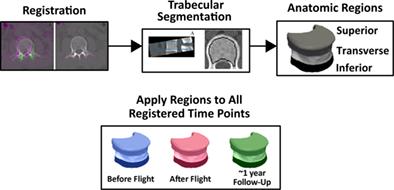{"title":"太空飞行和在地球上重新适应 1 年后脊椎骨密度和脊柱旁肌肉形态的变化","authors":"Jennifer C. Coulombe, Fjola Johannesdottir, Katelyn A. Burkhart, Henriette Brummer, Brett T. Allaire, Mary L. Bouxsein","doi":"10.1002/jbm4.10810","DOIUrl":null,"url":null,"abstract":"<p>Astronauts have an increased risk of back pain and disc herniation upon returning to Earth. Thus, it is imperative to understand the effects of spaceflight and readaptation to gravity on the musculoskeletal tissues of the spine. Here we investigated whether ~6 months of spaceflight led to regional differences in bone loss within the vertebral body. Additionally, we evaluated the relationships between vertebral bone density and paraspinal muscle morphology before flight, after flight, and after readaptation on Earth. We measured vertebral trabecular bone mineral density (Tb.BMD), paraspinal muscle cross-sectional area (CSA), and muscle density in 17 astronauts using computed tomography (CT) images of the lumbar spine obtained before flight (before flight, <i>n</i> = 17), after flight (spaceflight, <i>n</i> = 17), and ~12 months of readaptation to gravitational loading on Earth (follow-up, <i>n</i> = 15). Spaceflight-induced declines in Tb.BMD were greater in the superior region of the vertebral body (−6.7%) than the inferior (−3.1%, <i>p</i> = 0.052 versus superior region) and transverse regions (−4.3%, <i>p</i> = 0.057 versus superior region). After a year of readaptation to Earth's gravity, Tb.BMD in the transverse region remained significantly below preflight levels (−4.66%, <i>p</i> = 0.0094). Paraspinal muscle CSA and muscle density declined −1.0% (<i>p</i> = 0.005) and −0.83% (<i>p</i> = 0.001) per month of spaceflight, respectively. Ultimately, bone loss in the superior vertebral body, along with fatty infiltration of paraspinal muscles and incomplete recovery even after a year of readaptation on Earth, may contribute to spinal pathology in long-duration astronauts. © 2023 The Authors. <i>JBMR Plus</i> published by Wiley Periodicals LLC on behalf of American Society for Bone and Mineral Research.</p>","PeriodicalId":14611,"journal":{"name":"JBMR Plus","volume":"7 12","pages":""},"PeriodicalIF":3.4000,"publicationDate":"2023-11-08","publicationTypes":"Journal Article","fieldsOfStudy":null,"isOpenAccess":false,"openAccessPdf":"https://asbmr.onlinelibrary.wiley.com/doi/epdf/10.1002/jbm4.10810","citationCount":"0","resultStr":"{\"title\":\"Changes in Vertebral Bone Density and Paraspinal Muscle Morphology Following Spaceflight and 1 Year Readaptation on Earth\",\"authors\":\"Jennifer C. Coulombe, Fjola Johannesdottir, Katelyn A. Burkhart, Henriette Brummer, Brett T. Allaire, Mary L. Bouxsein\",\"doi\":\"10.1002/jbm4.10810\",\"DOIUrl\":null,\"url\":null,\"abstract\":\"<p>Astronauts have an increased risk of back pain and disc herniation upon returning to Earth. Thus, it is imperative to understand the effects of spaceflight and readaptation to gravity on the musculoskeletal tissues of the spine. Here we investigated whether ~6 months of spaceflight led to regional differences in bone loss within the vertebral body. Additionally, we evaluated the relationships between vertebral bone density and paraspinal muscle morphology before flight, after flight, and after readaptation on Earth. We measured vertebral trabecular bone mineral density (Tb.BMD), paraspinal muscle cross-sectional area (CSA), and muscle density in 17 astronauts using computed tomography (CT) images of the lumbar spine obtained before flight (before flight, <i>n</i> = 17), after flight (spaceflight, <i>n</i> = 17), and ~12 months of readaptation to gravitational loading on Earth (follow-up, <i>n</i> = 15). Spaceflight-induced declines in Tb.BMD were greater in the superior region of the vertebral body (−6.7%) than the inferior (−3.1%, <i>p</i> = 0.052 versus superior region) and transverse regions (−4.3%, <i>p</i> = 0.057 versus superior region). After a year of readaptation to Earth's gravity, Tb.BMD in the transverse region remained significantly below preflight levels (−4.66%, <i>p</i> = 0.0094). Paraspinal muscle CSA and muscle density declined −1.0% (<i>p</i> = 0.005) and −0.83% (<i>p</i> = 0.001) per month of spaceflight, respectively. Ultimately, bone loss in the superior vertebral body, along with fatty infiltration of paraspinal muscles and incomplete recovery even after a year of readaptation on Earth, may contribute to spinal pathology in long-duration astronauts. © 2023 The Authors. <i>JBMR Plus</i> published by Wiley Periodicals LLC on behalf of American Society for Bone and Mineral Research.</p>\",\"PeriodicalId\":14611,\"journal\":{\"name\":\"JBMR Plus\",\"volume\":\"7 12\",\"pages\":\"\"},\"PeriodicalIF\":3.4000,\"publicationDate\":\"2023-11-08\",\"publicationTypes\":\"Journal Article\",\"fieldsOfStudy\":null,\"isOpenAccess\":false,\"openAccessPdf\":\"https://asbmr.onlinelibrary.wiley.com/doi/epdf/10.1002/jbm4.10810\",\"citationCount\":\"0\",\"resultStr\":null,\"platform\":\"Semanticscholar\",\"paperid\":null,\"PeriodicalName\":\"JBMR Plus\",\"FirstCategoryId\":\"1085\",\"ListUrlMain\":\"https://onlinelibrary.wiley.com/doi/10.1002/jbm4.10810\",\"RegionNum\":0,\"RegionCategory\":null,\"ArticlePicture\":[],\"TitleCN\":null,\"AbstractTextCN\":null,\"PMCID\":null,\"EPubDate\":\"\",\"PubModel\":\"\",\"JCR\":\"Q2\",\"JCRName\":\"ENDOCRINOLOGY & METABOLISM\",\"Score\":null,\"Total\":0}","platform":"Semanticscholar","paperid":null,"PeriodicalName":"JBMR Plus","FirstCategoryId":"1085","ListUrlMain":"https://onlinelibrary.wiley.com/doi/10.1002/jbm4.10810","RegionNum":0,"RegionCategory":null,"ArticlePicture":[],"TitleCN":null,"AbstractTextCN":null,"PMCID":null,"EPubDate":"","PubModel":"","JCR":"Q2","JCRName":"ENDOCRINOLOGY & METABOLISM","Score":null,"Total":0}
引用次数: 0



